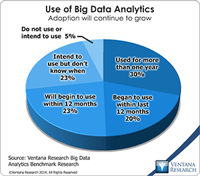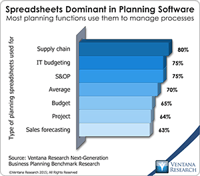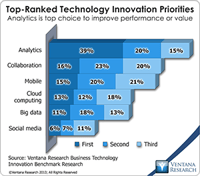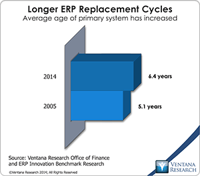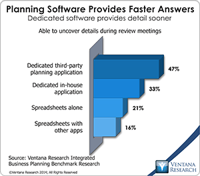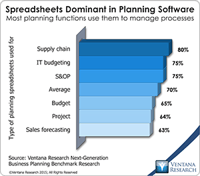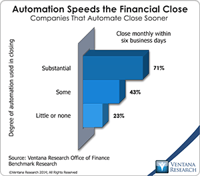Optimization is the application of algorithms to sets of data to guide executives and managers in making the best decisions. It’s a trending topic because using optimization technologies and techniques to better manage a variety of day-to-day business issues is becoming easier. I expect optimization, once the preserve of data scientists and operations research specialists will become mainstream in general purpose business analytics over the next five years.
Read More
Topics:
Big Data,
Performance Management,
Social Media,
Operational Performance Management (OPM),
Analytics,
Business Analytics,
Business Collaboration,
Business Performance Management (BPM),
Customer Performance Management (CPM),
Financial Performance Management (FPM),
Information Management (IM),
Sales Performance Management (SPM),
Supply Chain Performance Management (SCPM),
Price Optimization
Our benchmark research on next-generation business planning finds that a large majority of companies rely on spreadsheets to manage planning processes. For example, four out of five use them for supply chain planning, and about two-thirds for budgeting and sales forecasting. Spreadsheets are the default choice for modeling and planning because they are flexible. They adapt to the needs of different parts of any type of business. Unfortunately, they have inherent defects that make them...
Read More
Topics:
Planning,
Marketing Planning,
Operational Performance Management (OPM),
Reporting,
Budgeting,
Analytics,
Business Analytics,
Business Collaboration,
Business Performance Management (BPM),
Business Planning,
Customer Performance Management (CPM),
Financial Performance Management (FPM),
Sales Performance Management (SPM),
Supply Chain Performance Management (SCPM),
Demand Planning,
Integrated Business Planning
Unit4 is a global business software vendor focused on business and professional services, the public sector and higher education. Recently company executives met with industry analysts to provide an update of its strategic roadmap and to recap its accomplishments since being acquired by a private equity firm in 2014. Unit4 is the result of successive mergers of ERP and business software companies, notably CODA and Agresso. The company is also a part-owner (with salesforce.com and others) of...
Read More
Topics:
Predictive Analytics,
Office of Finance,
Operational Performance Management (OPM),
Human Capital,
Business Analytics,
Business Collaboration,
Business Performance Management (BPM),
Financial Performance Management (FPM)
Recently, Infor held its second innovation conference with industry analysts at its New York City headquarters. Infor’s products include the major categories of ERP, human capital management and financial performance management applications. Behind the marketing aspects of its use of “innovation” is a business strategy for retaining existing customers, migrating a sizable percentage of those customers to the cloud and gaining new customers. (Because of the relative size of the installed base,...
Read More
Topics:
Social Media,
Office of Finance,
Human Capital,
UX,
Business Analytics,
Business Collaboration,
Cloud Computing,
Business Performance Management (BPM),
Customer Performance Management (CPM),
Financial Performance Management (FPM)
Adaptive Insights held its annual user group meeting recently. A theme sounded in several keynote sessions was the importance of finance departments playing a more strategic role in their companies. Some participating customers described how they have evolved their planning process from being designed mainly to meet the needs of the finance department into a useful tool for managing the entire business. Their path took them from doing basic financial budgeting to planning focused on improving...
Read More
Topics:
Planning,
Operational Performance Management (OPM),
Reporting,
Budgeting,
Human Capital,
Analytics,
Business Analytics,
Business Collaboration,
Business Performance Management (BPM),
Business Planning,
Customer Performance Management (CPM),
Financial Performance Management (FPM),
Sales Performance Management (SPM),
Supply Chain,
Supply Chain Performance Management (SCPM),
Workforce Performance Management (WPM),
Demand Planning,
Integrated Business Planning,
Project Planning
In our benchmark research at least half of participants that use spreadsheets to support a business process routinely say that these tools make it difficult for them to do their job. Yet spreadsheets continue to dominate in a range of business functions and processes. For example, our recent next-generation business planning research finds that this is the most common software used for performing 11 of the most common types of planning. At the heart of the problem is a disconnect between what...
Read More
Topics:
Planning,
ERP,
Forecast,
GRC,
Office of Finance,
Operational Performance Management (OPM),
Reporting,
closing,
dashboard,
enterprise spreadsheet,
Excel,
Analytics,
Business Analytics,
Business Collaboration,
Business Intelligence,
Business Performance Management (BPM),
Customer Performance Management (CPM),
Data,
Financial Performance Management (FPM),
Risk,
Sales Performance Management (SPM),
Supply Chain Performance Management (SCPM),
application,
benchmark,
Financial Performance Management
Business planning includes all of the forward-looking activities in which companies routinely engage. Companies do a great deal of planning. They plan sales and determine what and how they will produce products or deliver services. They plan the head count they’ll need and how to organize distribution and their supply chain. They also produce a budget, which is a financial plan. The purpose of planning is to be successful. Planning is defined as the process of creating a detailed formulation of...
Read More
Topics:
Big Data,
Planning,
Predictive Analytics,
Marketing,
Office of Finance,
Operational Performance Management (OPM),
Reporting,
Budgeting,
Human Capital,
Sales and Forecasting,
Analytics,
Business Analytics,
Business Collaboration,
Business Performance Management (BPM),
Business Planning,
Customer Performance Management (CPM),
Financial Performance Management (FPM),
Sales Performance Management (SPM),
Supply Chain,
Supply Chain Performance Management (SCPM),
Demand Planning,
Integrated Business Planning,
Project Planning,
S&OP
Our recent Office of Finance benchmark research demonstrates the importance of using automation to execute finance department functions. Information technology systems do at least two things very well that make better use of people’s time, and both of them can substantially improve organizational performance. First, they eliminate the need for people to do repetitive tasks, which frees them to spend time on more valuable work that requires judgment and skill. IT systems also can be programmed...
Read More
Topics:
Big Data,
Mobile,
Planning,
ERP,
FP&A,
Office of Finance,
Reporting,
Self-service,
Budgeting,
close,
closing,
computing,
Controller,
dashboard,
Tax,
Analytics,
Business Analytics,
Business Collaboration,
Business Intelligence,
Cloud Computing,
Collaboration,
Business Performance Management (BPM),
CFO,
Data,
finance,
Financial Performance Management (FPM),
Financial Performance Management,
FPM,
Microsoft Excel,
Spreadsheets
Financial management software provider Intacct recently held its seventh annual user conference. In addition to a long list of enhancements in current and upcoming product releases, the company used the occasion to announce Intacct Collaborate, a capability built into its software that enables finance and accounting organizations to work together to answer questions or resolve issues while performing a process. Our benchmark research shows that collaboration ranks second in importance behind...
Read More
Topics:
Performance Management,
Salesforce.com,
ERP,
Human Capital Management,
NetSuite,
Office of Finance,
Reporting,
cloud ERP,
Analytics,
Business Analytics,
Business Collaboration,
Chatter,
Cloud Computing,
Collaboration,
Dashboards,
Business Performance Management (BPM),
Financial Performance Management (FPM),
FinancialForce,
Sales Performance Management (SPM),
Intacct
Financial management software provider Intacct recently held its fourth annual user conference. In addition to a long list of enhancements in current and upcoming product releases, the company used the occasion to announce Intacct Collaborate, a capability built into its software that enables finance and accounting organizations to work together to answer questions or resolve issues while performing a process. Our benchmark research shows that collaboration ranks second in importance behind...
Read More
Topics:
Performance Management,
Salesforce.com,
ERP,
Human Capital Management,
NetSuite,
Office of Finance,
Reporting,
cloud ERP,
Analytics,
Business Analytics,
Business Collaboration,
Chatter,
Cloud Computing,
Collaboration,
Dashboards,
Business Performance Management (BPM),
Financial Performance Management (FPM),
FinancialForce,
Sales Performance Management (SPM),
Intacct
